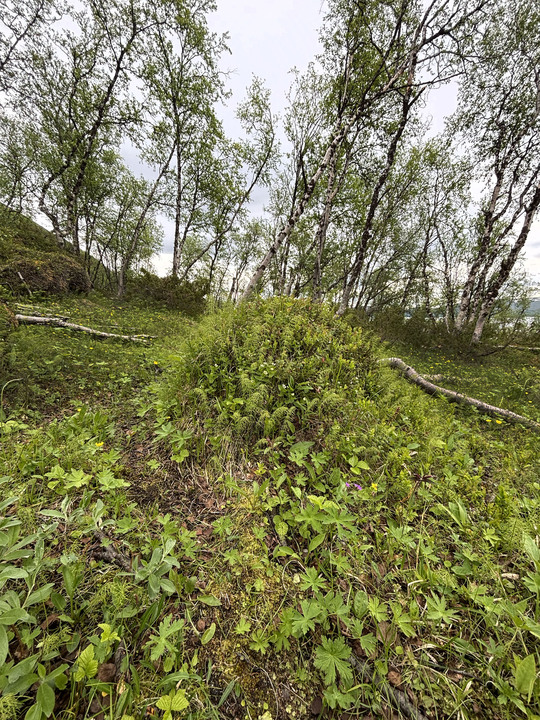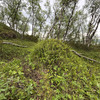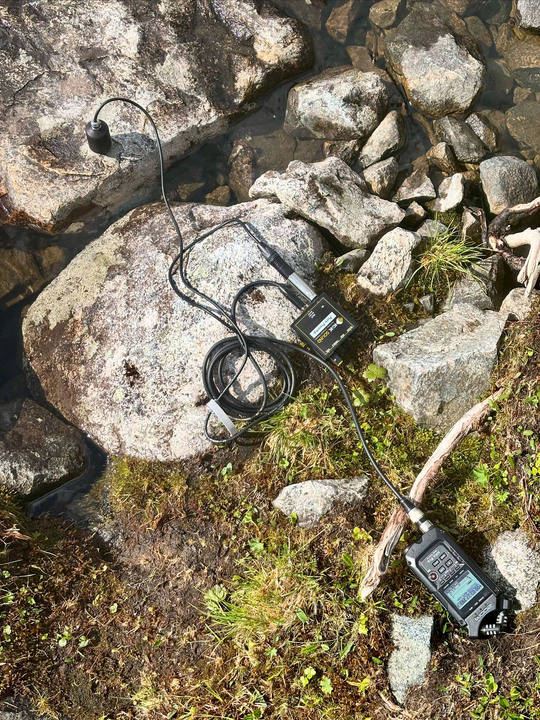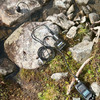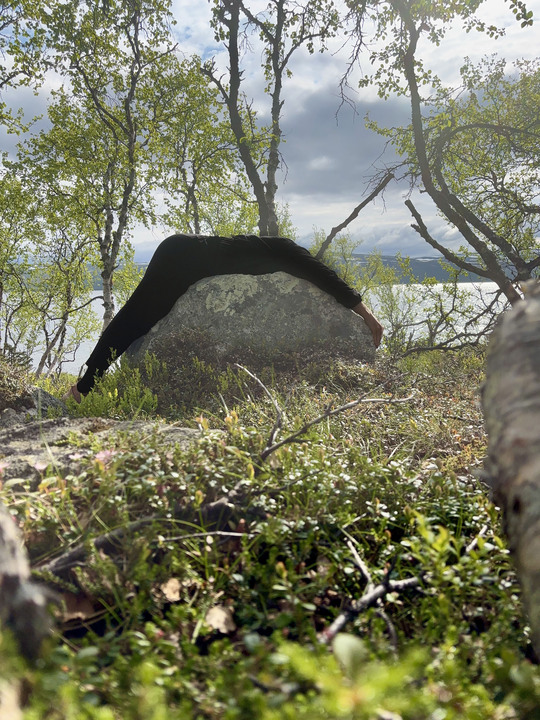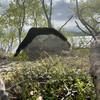It is easy to fall into the trap of viewing stones as stationary, unyielding, and unmalleable. Our human perception of time and movement limit our geologic imaginations, just as the metaphors of our language have set us into patterned understandings of the world. “Solid like a rock. Hard as stone.” But rocks are not forever, they move, they grow, they change. By thinking beyond the human experience into deeper geologic time scales we can learn from our elders about time, pressure, and change. My initial desire in visiting Kilpisjärvi was to touch some of the oldest rocks in the world. To see, feel and listen to them. The 2.8-billion-year-old granitoid rocks on the edges of the lake tell a story of transformation and migration as well as hardening and softening.
Queer theorist Sara Ahmed, writes in Willful Stones about a history filled with those who become unyielding as a way of surviving, those who protect themselves by becoming stone. The granodiorite of Kilpisjärvi offers another perspective where softening can also be a path towards longevity and survival. According to geologist Jaana Halla, the earth was originally a large magma ocean. Around 4.2 billion years ago the magma ocean started to cool, producing small solid land masses of dense mafic rocks (which are almost exclusively found on the ocean floors currently). Often these mafic rocks would encounter magma chambers causing them to melt and materially reorient themselves into less dense felsic rocks (which make up the continental crusts today). As the earth cooled the felsic rocks rose to the surface with water-based oceans covering the mafic rocks around 3.8 billion years ago. These softer, less dense rocks floated up to become our continental crusts capable of movement and collaboration while the more dense mafic rocks have sunk below the oceans. Being willing to soften provided felsic rocks with agency to shape their futures and explore opportunities for community building.
It is hypothesized that the felsic rock formations created three continents, Ur, Vaalbara, and Kenorland roughly 2.7 billion years ago.(1) Many believe that Kenorland was generally located close to the equator until magma plumes caused fractures in the land mass. The Baltic Shield broke off from Kenorland and continued to travel through the Atlantic Ocean to collide together with other crusts including parts of Australia and the Amazon to form the supercontinent of Columbia. (2) After about 500 million years rifts began appearing, pulling apart the supercontinent leaving land masses to reconstruct themselves into other continental formations. The Baltic Shield continued through several series of continental collaborations including the Rodinia Continent, as it moved south through the Atlantic Ocean to the South Pole before moving northward through the South Pacific.(3)
These push/pull cycles became the perfect events to spread the earliest lifeforms across large landmasses efficiently. 460 million years ago during the late Ordovician Period the Baltic Shield moved closer to another supercontinent and provided opportunities for trilobites to cross the ocean to new land masses.(4)Fossils of these trilobites as well as brachiopods, crinoids and corals, are found on all modern continents, and occupied every ancient ocean from which Paleozoic fossils have been collected. We can imagine how the movement of these continental crusts and their softness allowed them to merge with one another and play a critical role in the spread of life across the globe.
Finally, 425 million years ago the Baltic Shield moved northward to collide with the Laurentia continent and resulted in the creation of the Scandinavian Mountain range in its current location.(5) Buried under hundreds of meters of sediment, the 2.8-billion-year-old granitoid rocks were slowly revealed by millions of years of erosion. Archean rocks are exposed on earth’s surface in very few places like Canada, Australia, Africa and in the Baltic Shield, while most others have been broken down by erosion, melted or have been buried under miles of younger rocks and sediment.(6)
The deep geologic history of Kilpisjärvi's granitoid rocks is nothing short of phenomenal. However, this understanding cannot be grasped while sitting on a rock at the edge of the lake near the Kilpisjärvi Biological Station. You cannot feel the rocks move or sense their previous collaborations with Australia. Many geologists have told me that much of what sets these rocks apart cannot be measured "on site," that the analysis to determine age, typology or connections to previous hypothetical supercontinents is done in labs far from Kilpisjärvi.
So, what can we begin to know from first person experiences with this bedrock? During my two-week residency I sought out these ancient rocks from the area around the station to observe, feel and listen to. Seeing these granitoid rocks in the environment I noticed that they are not only part of an ecosystem but become hosts for a series of local flora as well. Covered in mats woven of Lapland cornel, bilberry, broom fork moss, wavy hairgrass, blue mountain heath and others, these rocks camouflage themselves as lumpy landscapes, trading their rock-ness for collaboration and community. Many of the rocks give up their whole selves in exchange for thick blankets of connection with their surroundings. Others peek out from under the warmth of their collaborators, revealing their hardness as a support system for their younger softer peers. Imagining what it may feel like to be supported by the elders of this community, I became moss. Draping myself over naked rocks feeling their support, their strength, and their willingness to become something new with me.
Listening to our elders' stories is vital both to understanding how the world came to be and imagining what the world can become. I brought geologic microphones with me to Kilpisjärvi to record the voices of our 2.8-billion-year-old ancestors. Mounting these microphones to multiple rock surfaces I was eager to hear the slow measured voices of rocks moving and thinking at geologic speed. I chose a variety of rocks to listen to: large, small, rock faces flat against the ground only revealed through walking repeatedly wearing down the blanket of moss, rocks with small branches scraping against the surface with the wind, rocks peeping out of the lake with waters continually lapping, rocks where their flora covers have peeled back to expose the surface to the sun.
I anticipated that the granitoid rocks would speak slowly and subtly as I imagine they experienced time differently to us. I was ready for quiet, for the barely noticeable. I was shocked at the boldness and bodily experience of listening to these recordings. The voices of the rocks were fast, incredibly variable and resonated deep within my core. Even with headphones the sounds of the rocks were felt before being heard, in your chest and heart and head. The deep rumbling recordings took up space and kept your attention, never falling to the background or slowing to become "still." These rocks continually refuse the passive state; they are active participants in our ecosystems from shaping our continents to encouraging life (both 2 billion years ago and contemporarily) and have something to say if you offer them your attention.
We love to touch an old rock, a large tree, a fossil when a sign tells us of its age. However, we walk quickly over stones gleefully ignorant of the billions of years under our feet when the placard is absent. Many would say that to understand the importance of these rocks you should slow down, be still like a rock and sit passively as nature happens to you. But I think the best thing we can do is change. Transform ourselves from hard bodies that no longer serve us. Become soft to survive harsh environments, float rather than sink. Move towards potential collaborations. Use the energy from past successes to propel us towards new malleable forms of cooperation. To not become stuck in one form of existence or location but become active in shaping our environments and to support those who stick with us.
Further Reading:
-
Halla, J. (2005). "Neoarchean sanukitoids (2.74–2.70 Ga)" (PDF). In Halla, J.; Nironen, M.; Lauri, L. S.; Kurhila, M. I.; Käpyaho, A.; Sorjonen-Ward, P.; Äikäs, O. (eds.). Eurogranites 2005: Proterozoic and Archean Granites and Related Rocks of the Finnish Precambrian. University of Helsinki. Retrieved March 12, 2016.
- Zhao, G.; Cawood, P. A.; Wilde, S. A.; Sun, M. (2002). "Review of global 2.1–1.8 Ga orogens: implications for a pre-Rodinia supercontinent". Earth-Science Reviews. 59 (1): 125–162.
- Moores, E. M. (1991). "Southwest US-East Antarctic (SWEAT) connection: a hypothesis". Geology. 19 (5): 425–428.
-
Alfred Wegener (1966), The origin of continents and oceans, Biram John, Courier Dover, p. 246
- Gabrielsen, Roy H.; Faleide, Jan Inge; Pascal, Christophe; Braathen, Alvar; Nystuen, Johan Petter; Etzelmuller, Bernd; O'Donnel, Sejal (2010). "Latest Caledonian to Present tectonomorphological development of southern Norway". Marine and Petroleum Geology. 27 (3): 709–723.
-
Lidmar-Bergström, Karna (1988). "Denudation surfaces of a shield area in south Sweden". Geografiska Annaler. 70 A (4): 337–350.

